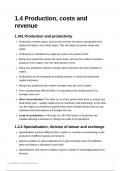1.4 Production, costs and
revenue
1.341 Production and productivity
Production converts inputs, such as the services of factors of production from
capital and labour, into a final output. This will satisfy consumer needs and
wants.
Productivity is calculated by output per worker per period of time.
Being more productive means the same input, such as the number of workers,
produces more output, over the same period of time.
Being less productive requires a larger input to produce the same quantity of
output.
Productivity can be increased by training workers or using more advanced
capital machinery.
Being more productive also lowers average costs per unit of output.
Firm is productively efficient when it is operating at the lowest point on its
average cost curve
Short run production: The short run is a time period when there is at least one
fixed factor input - usually capital such as machinery and technology. In the short
run, the output of a business expands when more variable factors such as raw
materials and extra workers are brought into use
Long run production: In the long run, all of the factors of production are
variable allowing a business to change the scale of its operations.
1.4.2 Specialisation, division of labour and exchange
Specialisation involves different firms, regions or countries concentrating on the
production of different goods and services.
Division of labour is when production for a good is broken down into different
tasks and labour is allocated to each task.
Specialisation and division of labour require a system of exchanging goods and
services.
1.4 Production, costs and revenue 1
, Advantages:
Higher output and potentially higher quality, since production focusses on what
people and businesses are best at.
There could be a greater variety of goods and services produced.
There are more opportunities for economies of scale, so the size of the market
increases.
There is more competition and this gives an incentive for firms to lower their
costs, which helps to keep prices down.
Disadvantages:
Work becomes repetitive, which could lower the motivation of workers,
potentially affecting quality and productivity. Workers could become dissatisfied.
There could be more structural unemployment, since skills might not be
transferable, especially because workers have focussed on one task for so long.
By producing a lot of one type of good through specialisation, variety could in
fact decrease for consumers.
There could be higher worker turnover for firms, which means employees
become dissatisfied with their jobs and leave regularly.
1.4.3 The law of diminishing returns and returns to
scale
Short Run Production: At least one of the factor inputs is fixed (usually this is
capital but can also be land). In the short run, businesses are constrained with
fixed & variable factors.
Long Run Production: All factors of production are variable, and the scale of
production can also change allowing a firm to benefit from economies of scale
Diminishing returns is a short run concept
Total product = total output (sometimes known as returns), or total units
produced
Marginal product = the additional output produced when an extra worker (or
other factor of
production) is employed (change in quantity produced / change in labour)
1.4 Production, costs and revenue 2
, Average product = total output ÷ number of workers. This is also the same as
productivity
The law of diminishing returns
In the short run, at least one factor of production is fixed. Let’s assume that this is
capital. The only way to increase output is to employ more workers. Initially, adding
an additional worker will cause productivity to rise, as the workers can use some
division of labour and focus on tasks that they are relatively better at. However, as
more workers are added to the fixed amount of capital, the capital becomes
increasingly scarce – there may not be enough to go round, causing workers to get
delayed and in each other’s way. This causes productivity to fall. At the point where
marginal product start to fall, we say that “diminishing returns has set in”.
When the marginal product of extra labour is falling – assuming that each worker is
paid the same wage rate – then the marginal cost of supplying extra output will
increase. Diminishing returns help to explain the conventional shape of the short-run
marginal cost curve.
1.4 Production, costs and revenue 3




